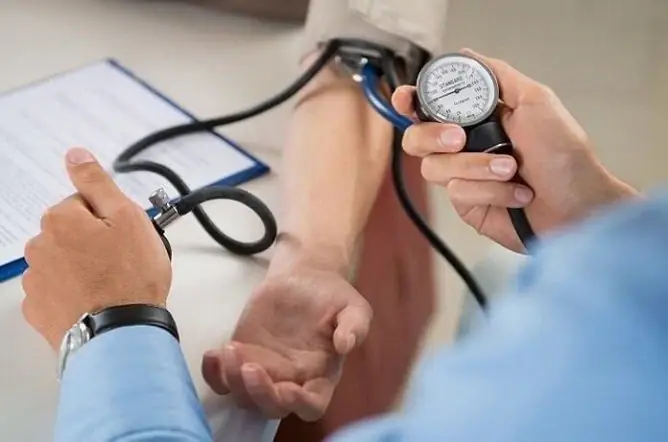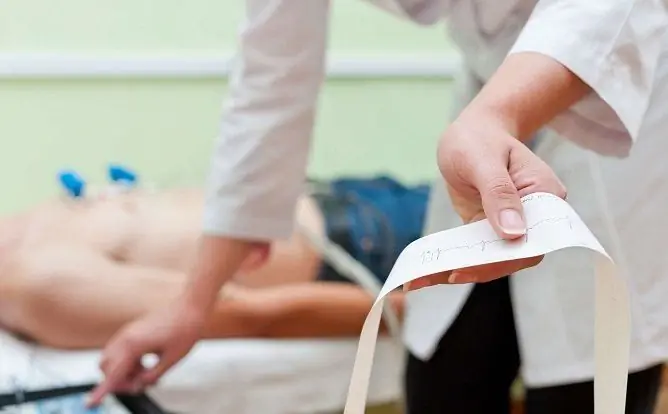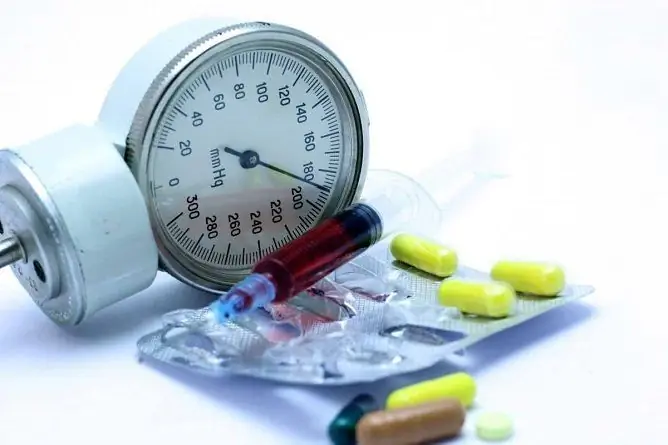- Author Rachel Wainwright [email protected].
- Public 2023-12-15 07:39.
- Last modified 2025-11-02 20:14.
The pressure jumps - then low, then high, what to do?
The content of the article:
- Causes and risk factors for blood pressure drops
- Symptoms of unstable blood pressure
- The pressure is low, then high, jumping - what to do?
- Video
If a person's pressure jumps, this has a more adverse effect on the body, especially on the cardiovascular and central nervous system, than when it is stably increased or decreased. Even relatively insignificant fluctuations in blood pressure (BP) by about 20% from the initial value in a short period of time negatively affect the functioning of the patient's brain and heart.
Distinguish between systolic (upper) and diastolic (lower) pressure. The conditional norm is 120 to 80 mm Hg. Art. BP is also considered normal at 10 mm Hg. Art. above or below the optimum value.

Sudden pressure drops are more dangerous than steady increases or decreases
Blood pressure jumps can occur in patients of all ages. In patients over 50 years of age, in the absence of adequate treatment, they lead to the development of myocardial infarction or stroke in more than 50% of cases. Therefore, people at risk are advised to regularly monitor their blood pressure levels at home, recording the result in a special diary.
Only a qualified specialist can determine why the pressure jumps. For this, he will need the results of a patient examination: laboratory tests, electrocardiography, ultrasound diagnostics of the abdominal cavity and / or kidneys, etc.
Causes and risk factors for blood pressure drops
Pressure drops up and down may indicate arterial hypertension developing in the patient. Other possible causes of pressure surges include:
- somatoform autonomic dysfunction of the nervous system (sometimes called vegetative dystonia);
- arrhythmia;
- ischemic heart disease, angina pectoris;
- violation of cerebral circulation;
- inflammatory processes and / or neoplasms of the brain;
- some diseases of the spine (in particular, with cervical osteochondrosis);
- pathology of the adrenal glands and thyroid gland;
- changes in hormonal levels in women during puberty and menopause, as well as in the premenstrual period;
- the use of a number of medicines;
- drinking coffee, alcoholic beverages, salty foods.
In addition, blood pressure jumps in a similar way in case of myocardial infarction, which can be both the cause of pressure surges and their consequences. When a stroke develops, the patient's blood pressure usually rises first and then falls.
Pressure surges are often observed during pregnancy. During this period, a woman's blood pressure level can change during the day. So, in the morning the pressure can be low, by the middle of the day this indicator rises, and by the evening the pressure drops again. After childbirth, some women also experience high blood pressure, which is usually caused by fatigue, stress, and sometimes neuropsychiatric disorders.
In meteosensitive people, the pressure does not change constantly, but in response to a change in the weather (ambient temperature, atmospheric pressure, etc.). People over 55 years old, patients with chronic diseases, endocrine disorders, and pathologies of the central nervous system are at risk of increased meteosensitivity. Pressure surges are possible when the climatic zone changes.
Risk factors for unstable blood pressure include: genetic predisposition, frequent stressful situations, neurological disorders, insufficient physical activity, excessive physical and / or intellectual stress, adverse effects of environmental factors, overweight. In young people, the most common causes of spikes in blood pressure are overwork and insufficient night sleep.
Smoking causes spasm of blood vessels, release of adrenaline, increased blood viscosity, impaired circulation, intoxication of the body. Long-term smoking can lead to hyper-, hypotension, and spikes in blood pressure.
Symptoms of unstable blood pressure
Signs of surges in blood pressure include: increasing weakness, fatigue, headache, dizziness, nausea, vomiting, alternation of pallor and hyperemia of the skin of the face, tremors of the upper and lower extremities, feeling of lack of air, heart problems, pain in the heart, muscle trembling all over the body, convulsions, fainting.
With a sharp increase in pressure, the patient may have tinnitus, increased sweating, the appearance of blackheads before the eyes. In the case of a decrease, the development of migraine is possible, there is a rapid pulse, darkening in the eyes, and fainting. A sharp decrease in blood pressure (for example, with allergic processes, infectious diseases) is dangerous for fainting and the likelihood of the patient getting injuries when falling.
During menopause, with changes in blood pressure, in addition to the main symptoms, there is an increased urge to urinate, a sharp change in mood, alternating heat and chills.
The main signs of pressure fluctuations in pregnant women are alternating sensations of heat and cold, darkening in the eyes, flashing flies before the eyes.
Why are changes in blood pressure dangerous? The patient's performance decreases, a sudden drop in blood pressure can cause the development of myocardial infarction or stroke, and the risk of rupture of blood vessels with subsequent hemorrhage increases.
The pressure is low, then high, jumping - what to do?
First of all, it is necessary to control blood pressure using a tonometer on both hands every 20-30 minutes for several hours. If pressure surges are confirmed, medical attention should be sought.
The patient should be provided with complete rest, access to fresh air. It is worth trying to determine the reason that led to the development of a pathological condition (alcohol, drugs, stressful situation, etc.).
If the patient has an increase in blood pressure after a decrease, you should help him to take a half-sitting position with his legs down, give him a medication, if one was prescribed by the attending physician.
If blood pressure drops after an increase, the patient is advised to lie on his back with his legs above the body. You can drink a cup of sweet coffee or tea, take a drug previously prescribed by your doctor.
If the patient's condition does not improve, it is necessary to call an ambulance team.
What pills to drink with jumps in blood pressure and whether it is possible to use certain folk remedies can be determined only after passing the examination and establishing the cause of this condition.
With pressure drops caused by a physiological change in hormonal levels (in puberty, during menopause), treatment is usually not required. Cardio training, swimming, Nordic walking, or other regular but moderate exercise are recommended. In other cases, drug therapy will help get rid of pressure surges (according to indications, hormonal drugs, sedatives, antihypertensive drugs, stimulating blood circulation, etc.) can be prescribed.
With pressure surges, especially sharp ones, during pregnancy, a woman is shown examination, and, if necessary, treatment in a hospital, since such a condition can be a sign of preeclampsia, which poses a danger to her and the fetus.

Blood pressure drops in pregnant women are the reason for a thorough examination
If the pressure drops are caused by taking medications, the condition usually returns to normal after the drug is discontinued or replaced.
Against the background of diabetes mellitus, arterial hypertension most often develops, but there are also drops in blood pressure. The primary task in this case is to bring blood pressure back to normal.
The prognosis for pressure drops depends on the general condition of the patient, the cause of the pathology and the timeliness of the start of treatment. Timely correction of blood pressure reduces the risk of complications by about 30%.
To get rid of the pathology, the patient should follow the recommendations regarding the lifestyle:
- rejection of bad habits;
- normalization of the work and rest regime;
- sufficient physical activity;
- avoidance of stress and physical overload;
- proper nutrition: the diet should include vegetables, fruits, lean meats and fish, limit the use of table salt;
- correction of excess weight, if any.
To prevent pressure surges, exercise therapy is recommended for about 40 minutes 3-4 times a week.
Persons from risk groups are recommended to undergo regular preventive medical examinations. With stress instability, you may need to consult a psychologist.
Caution should be observed by people whose professional activity is associated with unsafe mechanisms, requires increased concentration of attention, since with a sharp jump in pressure and impaired consciousness, they can not only find themselves in a dangerous situation themselves (falling down from a height, etc.), but also pose a danger to others.
Video
We offer for viewing a video on the topic of the article.

Anna Aksenova Medical journalist About the author
Education: 2004-2007 "First Kiev Medical College" specialty "Laboratory Diagnostics".
Found a mistake in the text? Select it and press Ctrl + Enter.






